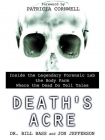Death's Acre: Inside The Legendary Forensic Lab The Body Farm Bill Bass (howl and other poems TXT) 📖

- Author: Bill Bass
Book online «Death's Acre: Inside The Legendary Forensic Lab The Body Farm Bill Bass (howl and other poems TXT) 📖». Author Bill Bass
Surprisingly, I took only one course from Krogman at Penn, but all those hours together in the car became my own personal tutorial with the world’s best bone detective. It was like an automobile-age version of the Socratic dialogs, but unlike Plato, I had the great teacher all to myself.
Krogman would assign me readings, and we’d discuss them as we drove back and forth. He had a fantastic memory for authors, dates, and publication titles, as well as every detail within the articles themselves. His ability to integrate knowledge from many sources, and to apply it to solve forensic problems, was phenomenal.
Krogman didn’t confine the tutorials to the car, either. Whenever he was given a forensic identification case—a set of bones from a puzzled county medical examiner or FBI agent—Krogman would call me into his lab. He would examine the bones first and formulate his analysis, but he would say absolutely nothing. Then he would ask me to look at the bones and draw my own conclusions. Then, as we compared findings, he demanded that I support and document my statements by citing recent scientific articles on the subject. Krogman was always surprised when I found something he’d overlooked. It didn’t happen often, but when it did, I glowed with pride.
Krogman’s teaching method was remarkably effective. Not only did it help me retain the material, it also prepared me to face courtroom questioning by hostile lawyers—something I’ve had to do many times in the subsequent years, though I couldn’t have foreseen it then. At the time, all I knew was that Krogman was guiding me, case by case and bone by bone, down a marvelous path.
All too soon the path forked. I left Penn to take a nine-month teaching post at the University of Nebraska in January of 1960, followed by eleven years at the University of Kansas in Lawrence. But my association with Krogman was far from over. We always stayed in close touch, personally and professionally. And when I trotted up the steps of the red brick headquarters of the New Jersey State Police in June of 1982, I found myself walking in Wilton Krogman’s footsteps once again.
Krogman had been asked by the New Jersey attorney general to examine the bones five years earlier, in 1977. Because of the lingering questions surrounding the Lindbergh case, the state was considering reopening the investigation. On the basis of Krogman’s findings, they chose not to. Now I was revisiting that same issue on behalf of the convicted killer’s widow.
By now I had attained a measure of professional standing of my own: I was the head of a thriving university anthropology department at the University of Tennessee in Knoxville, as well as the creator of what would come to be called “the Body Farm,” the world’s only forensic facility devoted to research on human decomposition. I had been named a fellow of the American Academy of Forensic Sciences and was serving as president of the organization’s physical anthropology section. I had examined thousands of skeletons and assisted with more than a hundred forensic cases. And yet, despite all that, I felt nervous and small: a pygmy walking in the footsteps of a giant. I would be only the second anthropologist ever given permission to examine the famous Lindbergh bones.
I was ushered into a basement room of the state police building. A few minutes later a clerk brought me a cardboard evidence box. Inside were five glass vials. One of the vials had cracked at some point; it was held together with clear tape. Originally these vials had kept expensive cigars from going stale. Now, sealed with cork stoppers, they guarded a dozen tiny bones against loss or breakage—bones that represented both the premature death of innocence and the final hope of an aging widow.
Two of the bones were clearly animal in origin: a two-inch piece of rib from a good-size bird, perhaps a grouse or quail, and a small vertebral arch, probably from the same bird. Both of these bore tooth marks on them—possibly from the same dog or dogs who had gnawed off the hands of the dead child hidden in the forest.
Of the ten human bones, the largest of them—the calcaneus, or heel, of the left foot—was about an inch and a quarter in diameter; to the untrained eye, it could have passed for a piece of gravel. Four of the bones were from the left foot; two were from the left hand; and four were from the right hand. Despite the passage of half a century, decayed tissue, dirt, and even a few hairs still clung to several.
Intact and undamaged, the bones bore no signs of trauma, no indication of cause of death. The only skeletal evidence that had pointed to that—the small fractured skull—had been cremated within hours after Charles Lindbergh identified the body as his son’s. What I held in my hands—these ten small bits of hands and a foot—had been sifted from ten baskets of leaves and twigs raked up from the forest floor in the days after the body’s discovery. The police had hoped to find answers—a murder weapon, a set of fingerprints, something that might point to who had stolen the child and what had gone wrong—but this handful of small bones shed precious little light.
Fifty years later they still illuminated little. In childhood, skeletons are androgynous: There’s no way to determine the sex of a skeleton; all you can do is measure





Comments (0)